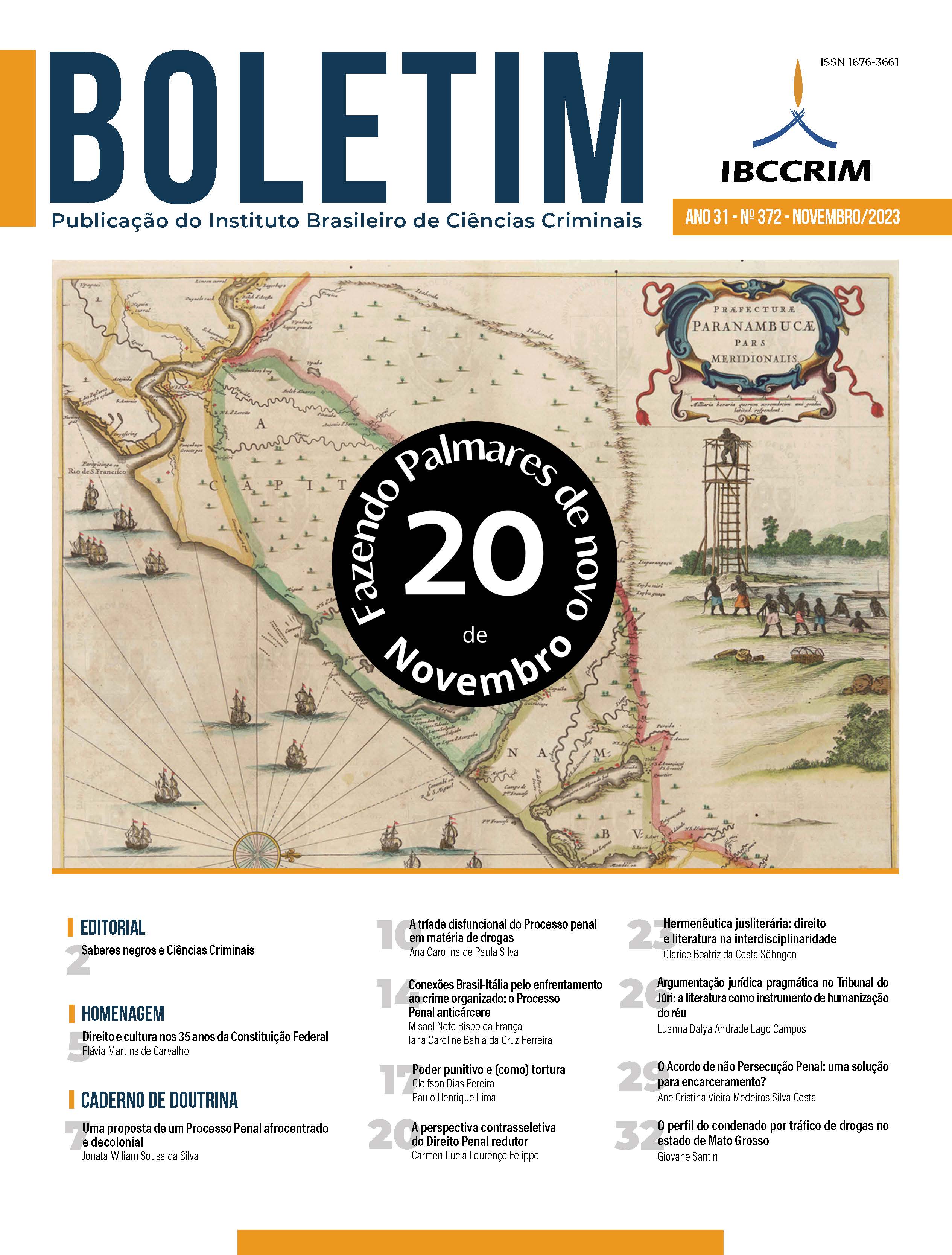Conexões Brasil-Itália pelo enfrentamento ao crime organizado: o Processo Penal anticárcere
Visualizações: 240DOI:
https://doi.org/10.5281/zenodo.10038595Palavras-chave:
Autoritarismo, Criminalização, RacionalizaçãoResumo
Para além da influência do contexto histórico presente na ascensão do fascismo italiano e da consolidação do Código Penal de Rocco (1930), em um contexto de ditadura varguista no Brasil (1937–1945), a Itália trouxe fortes influências à elaboração do ordenamento jurídico-penal brasileiro e às definições no âmbito da política criminal. Ao longo dos anos, o país europeu e o país latino-americano puderam aproximar-se em prol de um objetivo: juntos, combater o crime organizado de caráter transacional, que desafia as limitações de fronteiras e promove crescentemente o surgimento de discursos sobre a necessidade de maior rigor penal, ampla criminalização de condutas e endurecimento das penas. Por outro lado, um olhar sociológico sobre as prisões, especialmente no contexto brasileiro, demonstra que medidas encarceradoras não impedem nem controlam a ascensão do crime organizado, exibindo, portanto, a complexidade desse problema sistêmico e a necessidade de buscar, dentre as diversas formas de resolução de conflito existentes, aquelas que melhor se adequam à realidade social, preservando a dignidade da pessoa humana, e que, por fim, sejam dotadas de maior racionalidade.
Downloads
Publication Facts
Reviewer profiles Indisp.
Author statements
- Academic society
- Instituto Brasileiro de Ciências Criminais
- Publisher
- IBCCRIM
Referências
BRASIL. Supremo Tribunal Federal. Segunda Turma. HC 214243 AgR, Relator(a): Nunes Marques, julgado em: 13 jun. 2022. Processo Eletrônico DJe-119. Publicado em: 21 jun. 2022a.
BRASIL. Supremo Tribunal Federal. Primeira Turma. HC 215047 AgR, Relator(a): Alexandre de Moraes, julgado em 06 jun. 2022, Processo Eletrônico DJe-111. Publicado em: 08 jun. 2022b.
CARNELUTTI, Francesco. As misérias do processo penal. Tradução: Ricardo Gama. 3. ed. Campinas: Russel, 2009.
CASTRO, Rodrigo Costa Yehia; GIURA, Giuseppe; RICCIO, Vicente. O crime organizado no Brasil e na Itália. Análise de decisões. Revista de Informação Legislativa: RIL, Brasília, v. 57, n. 228, p. 77-92, out./dez. 2020. Disponível em: https://www12.senado.leg.br/ril/edicoes/57/228/ril_v57_n228_p77. Acesso em 13 out. 2023.
FAZZALARI, Elio. Instituições de direito processual. Tradução: Elaine Nassif. 8. ed. Campinas: Bookseller, 2006.
FERRAJOLI, Luigi. Direito e razão: teoria do garantismo penal. São Paulo: RT, 2002.
FRANÇA, Misael; VALVERDE; Bruno Leonardo. Tendências racionalizadoras no combate ao crime organizado – uma proposta descarcerizadora. DELICTAE: Revista de Estudos Interdisciplinares sobre o Delito, Belo Horizonte, v. 7, n. 13, p. 169-191, jul.-dez. 2022. https://doi.org/10.24861/25265180.v7i13.197
ITÁLIA. Ministero degli Affari Esteri e della Cooperazione Internazionale. Ambasciata d'Italia Brasilia. Firmato a Brasilia primo accordo Guardia di Finanza – Polizia Federale. Disponível em: https://ambbrasilia.esteri.it/it/news/dall_ambasciata/2023/04/firmato-a-brasilia-primo-accordo/. Acesso em 13 out. 2023.
MAIS RICA e poderosa que Cosa Nostra: como máfia italiana agiu no Brasil. Disponível em: https://noticias.uol.com.br/cotidiano/ultimas-noticias/2023/05/05/maior-que-cosa-nostra-e-ligacao-com-o-pcc-o-que-e-a-mafia-ndrangheta.htm. Acesso em 13 out. 2023.
RODAS, Sérgio. Operação 'mãos limpas' completa 30 anos com legado negativo. ConJur, 28 fev. 2022. Disponível em: https://www.conjur.com.br/2022-fev-28/operacao-maos-limpas-completa-30-anos-legado-negativo. Acesso em 13 out. 2023.
Mais rica e poderosa que Cosa Nostra: como a máfia italiana agiu no Brasil. UOL, 2023. Disponível em:https://noticias.uol.com.br/cotidiano/ultimas-noticias/2023/05/05/maior-que-cosa-nostra-e-ligacao-com-o-pcc-o-que-e-a-mafia-ndrangheta.htm. Acesso em 5 de maio de 2023Operação ‘Mãos Limpas’ completa 30 anos com legado negativo. Consultor Jurídico, 2023. Disponível em: https://www.conjur.com.br/2022-fev-28/operacao-maos-limpas-completa-30-anos-legado-negativo. Acesso em 5 de maio de 2023.ZAPPA, Regina. Chico Buarque para todos. Rio de Janeiro: Ímã Editorial, 2016.
Downloads
Publicado
Como Citar
Edição
Seção
Licença
Os direitos autorais dos artigos publicados são do autor, mas com direitos do periódico sobre a primeira publicação e com respeito ao período de exclusividade de um ano. Os autores somente poderão utilizar os mesmos resultados em outras publicações indicando claramente este periódico como o meio da publicação original. Se não houver tal indicação, considerar-se-á situação de autoplágio.
Portanto, a reprodução, total ou parcial, dos artigos aqui publicados fica sujeita à expressa menção da procedência de sua publicação neste periódico, citando-se o volume e o número dessa publicação. Para efeitos legais, deve ser consignada a fonte de publicação original, além do link DOI para referência cruzada (se houver).


 Português (Brasil)
Português (Brasil)
 English
English
 Español (España)
Español (España)










